UNITED STATES
SECURITIES AND EXCHANGE COMMISSION
Washington, D.C. 20549
FORM N-CSR
CERTIFIED SHAREHOLDER REPORT OF REGISTERED
MANAGEMENT INVESTMENT COMPANIES
Investment Company Act File Number: 811-04998
| T. Rowe Price Spectrum Fund, Inc. |
|
| (Exact name of registrant as specified in charter) |
| |
| 100 East Pratt Street, Baltimore, MD 21202 |
|
| (Address of principal executive offices) |
| |
| David Oestreicher |
| 100 East Pratt Street, Baltimore, MD 21202 |
|
| (Name and address of agent for service) |
Registrant’s telephone number, including area code: (410) 345-2000
Date of fiscal year end: December 31
Date of reporting period: December 31, 2014
Item 1. Report to Shareholders
| Spectrum Fund | December 31, 2014 |
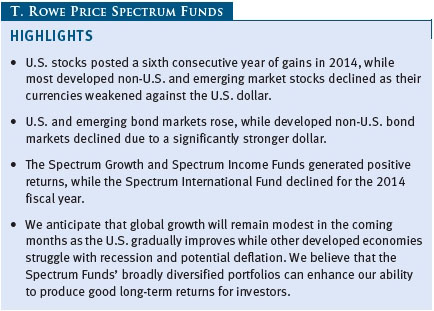
The views and opinions in this report were current as of December 31, 2014. They are not guarantees of performance or investment results and should not be taken as investment advice. Investment decisions reflect a variety of factors, and the managers reserve the right to change their views about individual stocks, sectors, and the markets at any time. As a result, the views expressed should not be relied upon as a forecast of the fund’s future investment intent. The report is certified under the Sarbanes-Oxley Act, which requires mutual funds and other public companies to affirm that, to the best of their knowledge, the information in their financial reports is fairly and accurately stated in all material respects.
REPORTS ON THE WEB
Sign up for our E-mail Program, and you can begin to receive updated fund reports and prospectuses online rather than through the mail. Log in to your account at troweprice.com for more information.
Manager’s Letter
Fellow Shareholders
U.S. stocks posted a sixth consecutive year of gains in 2014—with the major equities indexes closing at or near record levels as the economy strengthened, employment improved, and profits expanded. Stocks in developed non-U.S. markets declined. Most emerging markets declined but held up better than developed non-U.S. markets. Stocks in Japan declined in dollar terms as the country fell into recession. U.S. investment-grade bonds produced strong returns, while bonds in developed non-U.S. markets declined. Emerging markets debt generated good returns, outpacing high yield bonds. The Spectrum Growth Fund trailed its benchmark and peer group for the year ended December 31, 2014. The Spectrum Income Fund lagged its benchmark but outpaced its peer group, while the Spectrum International Fund outperformed both its benchmark and peer group average.
MARKET ENVIRONMENT
U.S. equities rose as the economy rebounded from a first-quarter weather-related contraction. Falling long-term interest rates—despite the Federal Reserve’s reduction of asset purchases—solid employment growth, favorable corporate earnings, and expanded stimulus measures by major non-U.S. central banks were also supportive. Stagnant global growth, heightened geopolitical tensions surrounding sanctions against Russia for its actions in Ukraine, and unrest in the Middle East periodically weighed on stock prices as did concerns that the Fed would begin raising short-term interest rates. However, stimulus actions by the European Central Bank (ECB) and Bank of Japan (BoJ) helped boost investor sentiment. In the near term, while falling oil prices weigh on the energy sector, lower energy costs could help boost U.S. consumer and business spending and provide relief to major oil-importing nations.
Against this backdrop, large- and mid-cap stocks outpaced small-caps over the last year. According to various Russell indexes, value stocks outperformed growth stocks among large- and mid-caps, while the opposite was true for small-cap shares.
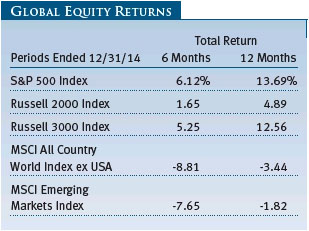
Many stocks in developed non-U.S. markets declined. Developed Asian markets held up best. In Japan, stocks fell as the economy entered a recession following an April sales tax increase that significantly curtailed consumer spending. European markets declined overall as eurozone economies struggled with low inflation, high unemployment, and a loss of consumer and business confidence. Emerging Asian markets produced solid gains and outperformed the broad emerging markets universe in aggregate. Some of the top performers included countries where reform-minded leaders were elected and introduced measures to spur economic growth. Latin American markets mostly declined, while in emerging Europe, Russian shares plummeted nearly 46% in dollar terms as the economy struggled with U.S. and European Union sanctions, falling oil prices, and severe currency weakness.
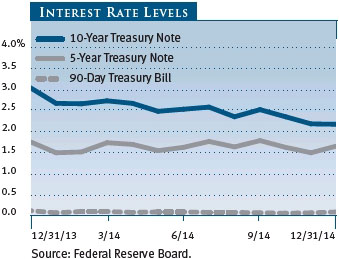
High-quality U.S. bonds generated solid returns over the past year. Among investment-grade bonds, long-term Treasuries performed best, benefiting from declining yields due to global economic weakness and geopolitical uncertainties and despite the Fed’s tapering of its asset purchases. High yield bonds trailed investment-grade issues for the year as steeply falling oil prices weighed on energy sector bonds, the largest segment of the high yield market. Investment-grade corporate bonds advanced as the asset class benefited from falling Treasury yields, strong demand, and tighter credit spreads for most of the year. Agency mortgage-backed securities produced good returns, overcoming reduced demand from the Fed.
Bonds in developed non-U.S. markets produced losses in U.S. dollar terms. The dollar strengthened significantly versus other major currencies, more than offsetting the local-currency gains stemming from the overall decline of yields in key government bond markets. Emerging markets debt outperformed bonds in developed non-U.S. markets as demand for higher-yielding assets persisted and as concerns about the impact of the Fed ending asset purchases on global liquidity diminished. Dollar-denominated bonds performed much better than local-currency debt as most emerging markets currencies declined sharply versus the dollar, reducing returns to U.S. investors in dollar terms.
SPECTRUM GROWTH FUND
The Spectrum Growth Fund returned -0.26% and 5.60%, respectively, for the 6- and 12-month periods ended December 31, 2014. The fund underperformed both its index, the Russell 3000 Index, and its peer group, the Lipper Multi-Cap Core Funds Index. Underperformance was primarily due to the inclusion of diversifying sectors not included in the benchmark. In particular, our exposure to developed non-U.S. equities—both growth and value—and emerging markets equities detracted from relative performance. The inclusion of real assets equities through the underlying Real Assets Fund also detracted as the oil prices declined. This globally diversified fund invests in companies that own, or whose sales are related to, assets with physical properties, such as energy and natural resources, real estate, basic materials, equipment, utilities, and commodities. Stock selection also weighed on relative performance, particularly within U.S. large-cap equities, as several underlying portfolios underperformed their style-specific benchmarks. However, stock selection within non-U.S. equities contributed, as the underlying international and emerging markets portfolios outperformed their style-specific benchmarks.
The Spectrum Growth Fund invests in a range of underlying funds that focus on domestic stocks across all market capitalizations and international stocks in developed and emerging markets. With international markets in earlier stages of their recovery cycle, we favor non-U.S. stocks as valuations are more attractive than U.S. equities. The potential for continued central bank easing policies in Europe and Japan, while supportive for growth, could weaken their currencies versus the U.S. dollar and weigh on returns in dollar terms. We are overweight to emerging markets equities as valuations are attractive relative to developed markets. The potential for slowing emerging markets growth and for a less accommodative Fed policy to result in higher interest rates and increased volatility remain near-term risks. Declining energy and commodity prices have the potential to create further divergence across emerging markets economies by hurting commodity exporters, while consumer-driven and service-oriented economies benefit from lower prices.
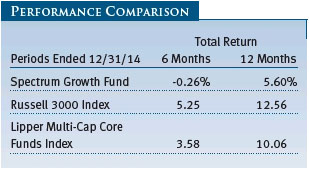
Within domestic stocks, we favor large-cap stocks versus small-caps, as small-cap valuations appear to be fully valued. We also favor growth stocks to value stocks; however, our allocation is modestly overweight. While the current low level of economic growth favors growth stocks, which tend to be less reliant than cyclical companies on a strong economy to support rising earnings, a gradually improving economy has prompted us to moderate our commitment to growth stocks relative to value.
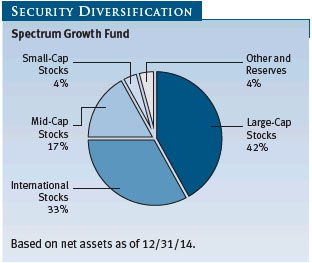
We remain underweight to real assets equities as the prospects for muted global economic growth are likely to continue weighing on energy and materials prices, especially with increased global energy production capacity and the impact of drilling technology improving supply. Demand for commodities is expected to remain subdued as China continues shifting its growth model away from industrial production and exports and toward domestic consumption. Real interest rates are currently at low levels, and rising real rates have historically been less favorable for real assets-related equities. Although fundamentals for real estate investment trusts (REITs) are favorable, valuations remain rich, and the sector is susceptible to shifts in interest rates.
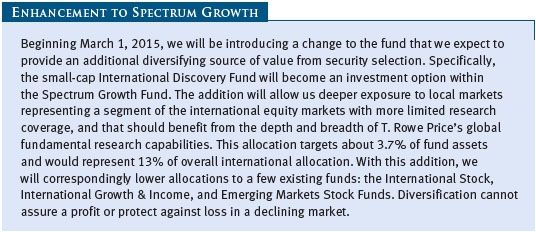
SPECTRUM INCOME FUND
The Spectrum Income Fund returned -1.30% and 3.88% respectively for the 6- and 12-month periods ended December 31, 2014, underperforming the Barclays U.S. Aggregate Bond Index but outpacing its peer group, the Lipper Multi-Sector Income Funds Average. Security selection within the underlying portfolios was the largest detractor from relative performance primarily due to selection within our underlying dividend-paying equity and emerging markets bond portfolios as each underperformed its style-specific benchmark. Investments in diversifying sectors not represented in the benchmark also detracted from relative performance, notably exposure to non-U.S. dollar bonds and high yield bonds. However, exposure to dividend-paying equities contributed to relative performance. The ability to include allocations to diversifying sectors not in the benchmark in order to gain exposure to a broad range of income sources is a key feature of the Spectrum Income Fund’s design. The decisions to underweight or overweight various asset classes also weighed on relative performance. An underweight to U.S. long-term Treasuries, which rallied during the period, detracted; however, our underweight to nondollar-denominated bonds contributed to relative performance.
After reducing our overweight to high yield bonds over the course of the year, we slightly increased that allocation at the end of the period relative to investment-grade bonds as recent underperformance has provided an opportunity to take advantage of higher yields and better prices. High yield bonds remain attractive relative to other sectors in this low yield environment, particularly given prospects for a slowly improving economy and low default expectations. However, we continue to monitor the spread-widening and credit impact in the energy- and commodity-related sectors, which represent a significant portion of the market. In general, the high yield sector offers a yield advantage and lower-duration profile, making them less sensitive to rising interest rates than higher-quality bonds with similar or extended maturities.
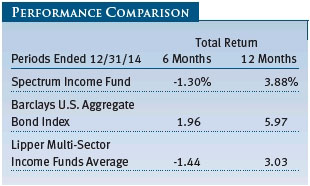
We moved to a modest overweight to emerging markets debt versus U.S. investment-grade bonds in December from a neutral position, as the underperformance of emerging markets debt over the last several months has offered more attractive yields. Emerging markets bonds have been supported during 2014 by low U.S. interest rates and mostly market-friendly outcomes in many key elections. Muted growth and the start of Fed interest rate policy normalization remain near-term risks. Considerable disparity exists in the strength of various emerging markets economies, with the potential for declining commodity prices to amplify the differences. Lower commodity prices are a positive for many commodity importers in reducing inflation and providing policy flexibility, while the fiscal positions of commodity exporters are vulnerable.
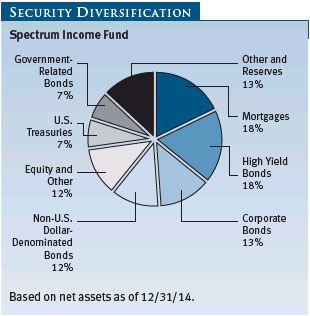
We favor U.S. investment-grade bonds versus non-U.S.-dollar-denominated debt and increased our overweight during the year based largely on the prospects for continued stronger growth and higher domestic interest rates relative to other developed countries. Further policy actions by the ECB and BoJ to stimulate growth and inflation could provide a catalyst for their currencies to decline even further relative to the dollar.
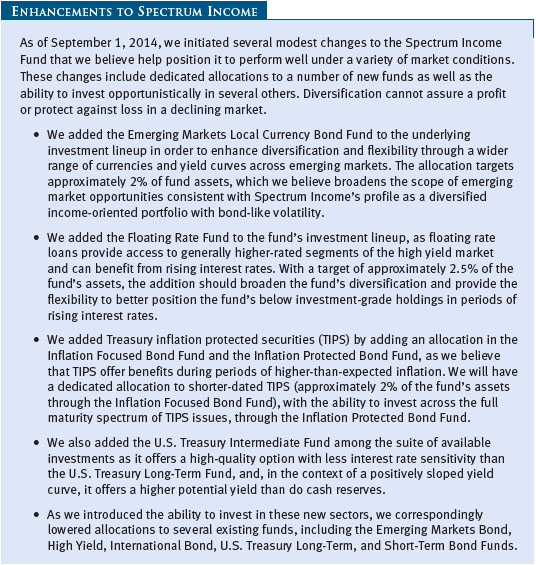
SPECTRUM INTERNATIONAL FUND
The Spectrum International Fund returned -7.84% and -3.07%, respectively, for the 6- and 12-month periods ended December 31, 2014, outperforming both the benchmark MSCI All Country World Index ex USA, and its peer group, the Lipper International Multi-Cap Growth Funds Average. The fund’s emerging Asia holdings were among the top-performing regions as several important markets responded positively to the election of reform-minded leaders who introduced measures to spur economic growth. In addition, falling oil prices cut import costs and helped shrink current account deficits among energy importers. Among our top contributors were underlying funds with substantial exposure to developed and emerging Asian markets, which performed relatively well over the past year. The New Asia and Emerging Markets Stock Funds each generated positive absolute returns and outpaced their respective style-specific benchmarks. The Africa & Middle East Fund was the strongest absolute and relative performer, primarily due to stock selection. Underlying funds focused primarily on non-U.S. developed markets, which declined, including the International Growth & Income Fund and the European Stock Fund, were the largest detractors from performance. The strengthening dollar, deflation worries in Europe, and recession in Japan weighed on developed non-U.S. markets.
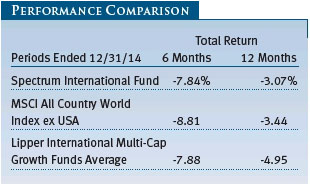
At the close of the period, Europe was our largest regional exposure, representing about one-half of the fund’s assets. We slightly increased our allocation to the Pacific ex-Japan region—which represents about one-quarter of the fund’s assets—since our last report. We also slightly decreased our exposure to Latin America and North America. We are generally overweight emerging markets equities.
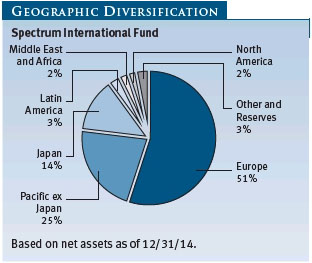
OUTLOOK
We believe that global growth over the next several quarters will remain modest. In the U.S., diminishing fiscal headwinds, expanding private sector demand, and moderate job growth should support gradual economic improvement. We expect corporate capital expenditures to continue to progress, with gross domestic product growth close to 3.0% for 2015. With U.S. corporate balance sheets and profit margins healthy, and revenue growth in the low- to mid-single digits consistent with modest economic growth, we expect earnings growth to trend toward the mid-single digits over the coming quarters, although a stronger dollar presents a headwind to earnings for U.S. multinationals. While lower energy prices support consumer spending, they are likely to weigh on energy sector earnings growth and balance sheets.
In contrast, European growth has softened amid concerns over deflation, and the region remains hindered by high debt loads and high unemployment. We expect ongoing accommodative monetary policies from the ECB and the BoJ along the lines of the large increase in securities purchases that the Japanese central bank announced at the end of the reporting period, which should help spur growth and inflation. These actions are likely to stand in contrast with steps toward policy normalization that the Fed and the Bank of England are likely to implement sometime in 2015. This divergence in monetary policy could also put pressure on the euro and the yen relative to the U.S. dollar, which would weigh on eurozone and Japanese returns in dollar terms. In emerging markets, broad divergences have also become apparent across economies as commodity exporters lose ground while consumer- and service-driven economies benefit from lower prices.
The impending divergence in monetary policy globally could generate significant volatility across global financial markets, as they adjust to interest rates and growth trends moving in varying directions. We believe that the Spectrum Funds’ broadly diversified portfolios and investment approaches can enhance our ability to produce good long-term returns despite the potential effect of these divergences.
Thank you for investing with T. Rowe Price.
Respectfully submitted,

Charles M. Shriver
Portfolio manager, Spectrum Growth, Spectrum Income, and Spectrum International Funds
January 16, 2015
The committee chairman has day-to-day responsibility for managing the portfolios and works with committee members in developing and executing the funds’ investment programs.
T. Rowe Price Spectrum Growth Fund
| Supplement to Summary Prospectus Dated May 1, 2014 |
Effective March 1, 2015, the T. Rowe Price International Discovery Fund will be added to the list of underlying funds in which the Spectrum Growth Fund can invest.
On page 2, the Asset Allocation Ranges for Underlying Funds table is supplemented as follows:

RISKS OF INVESTING
As with all stock and bond mutual funds, each fund’s share price can fall because of weakness in the stock or bond markets, a particular industry, or specific holdings. Stock markets can decline for many reasons, including adverse political or economic developments, changes in investor psychology, or heavy institutional selling. The prospects for an industry or company may deteriorate because of a variety of factors, including disappointing earnings or changes in the competitive environment. In addition, the investment manager’s assessment of companies held in a fund may prove incorrect, resulting in losses or poor performance even in rising markets.
Bonds are subject to interest rate risk, the decline in bond prices that usually accompanies a rise in interest rates, and credit risk, the chance that any fund holding could have its credit rating downgraded or that a bond issuer will default (fail to make timely payments of interest or principal), potentially reducing the fund’s income level and share price. High yield corporate bonds could have greater price declines than funds that invest primarily in high-quality bonds. Companies issuing high yield bonds are not as strong financially as those with higher credit ratings, so the bonds are usually considered speculative investments.
Funds that invest overseas may carry more risk than funds that invest strictly in U.S. assets. Risks can result from varying stages of economic and political development; differing regulatory environments, trading days, and accounting standards; and higher transaction costs of non-U.S. markets. Non-U.S. investments are also subject to currency risk, or a decline in the value of a foreign currency versus the U.S. dollar, which reduces the dollar value of securities denominated in that currency.
GLOSSARY
Barclays U.S. Aggregate Bond Index: An unmanaged index that tracks investment-grade corporate and government bonds.
Credit spreads: The amount of additional yield demanded by bond investors in exchange for buying riskier assets.
Gross domestic product: The total market value of all goods and services produced in a country in a given year.
J.P. Morgan Non-U.S. Dollar Government Bond Index: An unmanaged index that tracks the performance of major non-U.S. bond markets.
Lipper averages: The averages of available mutual fund performance returns for specified time periods in categories defined by Lipper Inc.
Lipper indexes: Fund benchmarks that consist of a small number of the largest mutual funds in a particular category as tracked by Lipper Inc.
MSCI All Country World Index ex USA: An index that measures equity market performance of developed and emerging countries, excluding the U.S.
MSCI EAFE Index: An unmanaged index that tracks the stocks of about 1,000 companies in Europe, Australasia, and the Far East (EAFE).
MSCI Emerging Markets Index: An unmanaged index that tracks stocks in 26 emerging market countries.
Russell 2000 Index: An unmanaged index that tracks the stocks of 2,000 small U.S. companies.
Russell 3000 Index: An index that tracks the performance of the 3,000 largest U.S. companies, representing approximately 98% of the investable U.S. equity market.
S&P 500 Index: An unmanaged index that tracks the stocks of 500 U.S. primarily large-cap companies.
Weighted average effective duration (years): A measure of a security’s price sensitivity to changes in interest rates. Securities with longer durations are more sensitive to changes in interest rates than securities of shorter durations.
Weighted average maturity: A measure of a fund’s interest rate sensitivity. In general, the longer the average maturity, the greater the fund’s sensitivity to interest rate changes. The weighted average maturity may take into account interest rate readjustment dates for certain securities. Money funds must maintain a weighted average maturity of less than 60 days.
Note: MSCI makes no express or implied warranties or representations and shall have no liability whatsoever with respect to any MSCI data contained herein. The MSCI data may not be further redistributed or used as a basis for other indices or any securities or financial products. This report is not approved, reviewed, or produced by MSCI.
Note: Russell Investment Group is the source and owner of the trademarks, service marks, and copyrights related to the Russell indexes. Russell® is a trademark of Russell Investment Group.
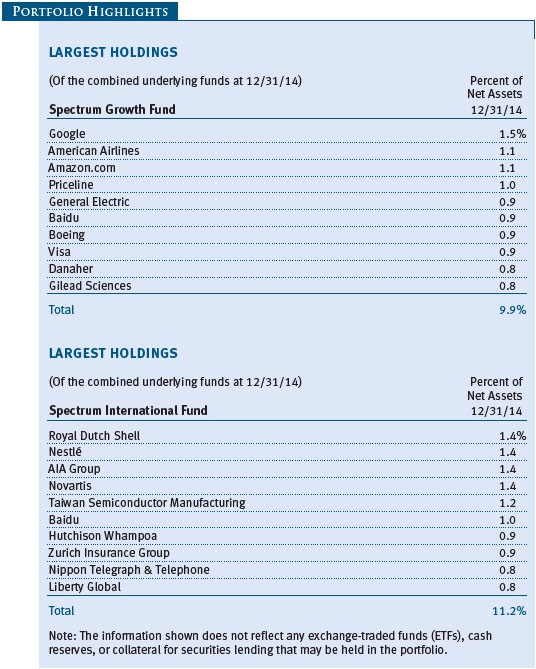
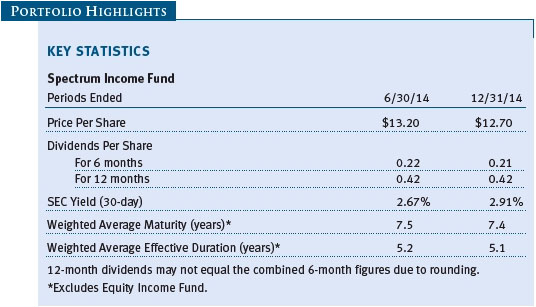
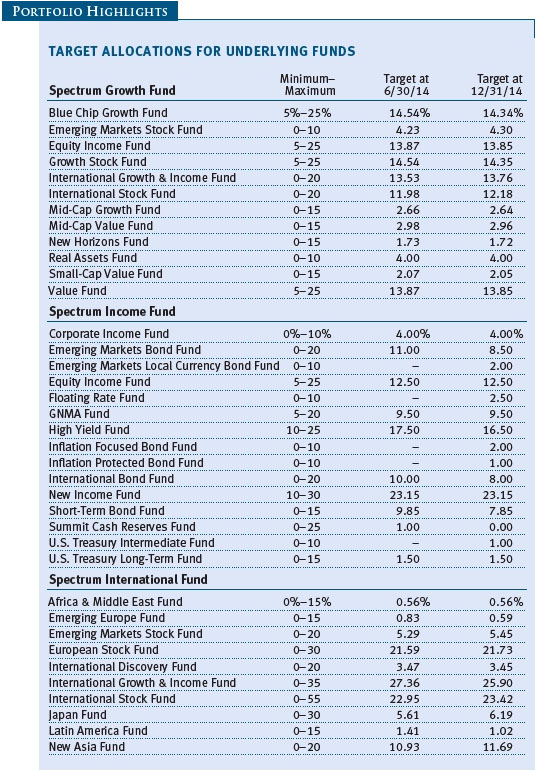
Performance and Expenses
This chart shows the value of a hypothetical $10,000 investment in the fund over the past 10 fiscal year periods or since inception (for funds lacking 10-year records). The result is compared with benchmarks, which may include a broad-based market index and a peer group average or index. Market indexes do not include expenses, which are deducted from fund returns as well as mutual fund averages and indexes.
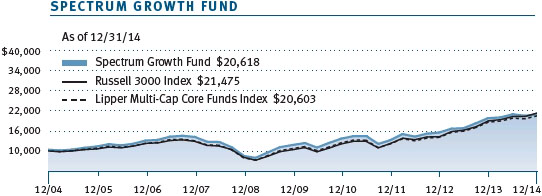
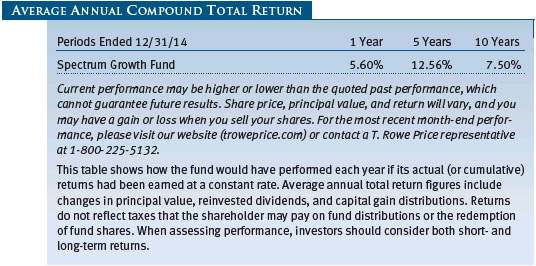
This chart shows the value of a hypothetical $10,000 investment in the fund over the past 10 fiscal year periods or since inception (for funds lacking 10-year records). The result is compared with benchmarks, which may include a broad-based market index and a peer group average or index. Market indexes do not include expenses, which are deducted from fund returns as well as mutual fund averages and indexes.
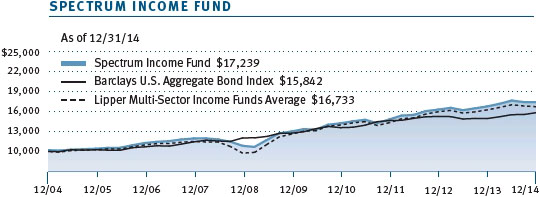
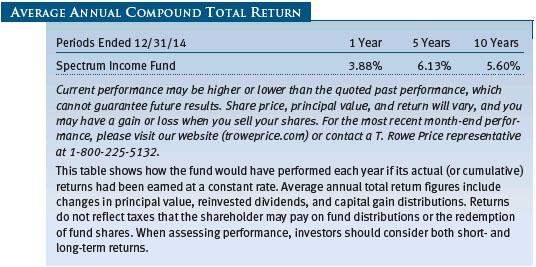
This chart shows the value of a hypothetical $10,000 investment in the fund over the past 10 fiscal year periods or since inception (for funds lacking 10-year records). The result is compared with benchmarks, which may include a broad-based market index and a peer group average or index. Market indexes do not include expenses, which are deducted from fund returns as well as mutual fund averages and indexes.
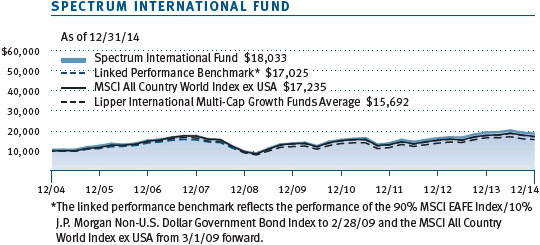
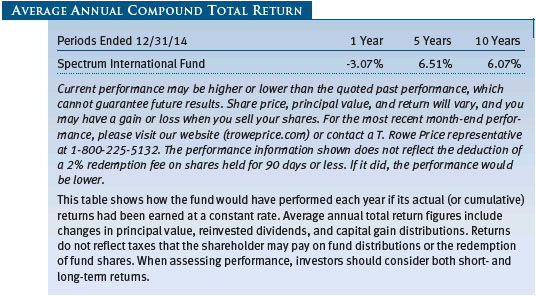

As a mutual fund shareholder, you may incur two types of costs: (1) transaction costs, such as redemption fees or sales loads, and (2) ongoing costs, including management fees, distribution and service (12b-1) fees, and other fund expenses. The following example is intended to help you understand your ongoing costs (in dollars) of investing in the fund and to compare these costs with the ongoing costs of investing in other mutual funds. The example is based on an investment of $1,000 invested at the beginning of the most recent six-month period and held for the entire period.
Actual Expenses
The first line of the following table (Actual) provides information about actual account values and expenses based on the fund’s actual returns. You may use the information on this line, together with your account balance, to estimate the expenses that you paid over the period. Simply divide your account value by $1,000 (for example, an $8,600 account value divided by $1,000 = 8.6), then multiply the result by the number on the first line under the heading “Expenses Paid During Period” to estimate the expenses you paid on your account during this period.
Hypothetical Example for Comparison Purposes
The information on the second line of the table (Hypothetical) is based on hypothetical account values and expenses derived from the fund’s actual expense ratio and an assumed 5% per year rate of return before expenses (not the fund’s actual return). You may compare the ongoing costs of investing in the fund with other funds by contrasting this 5% hypothetical example and the 5% hypothetical examples that appear in the shareholder reports of the other funds. The hypothetical account values and expenses may not be used to estimate the actual ending account balance or expenses you paid for the period.
Note: T. Rowe Price charges an annual account service fee of $20, generally for accounts with less than $10,000. The fee is waived for any investor whose T. Rowe Price mutual fund accounts total $50,000 or more; accounts electing to receive electronic delivery of account statements, transaction confirmations, prospectuses, and shareholder reports; or accounts of an investor who is a T. Rowe Price Preferred Services, Personal Services, or Enhanced Personal Services client (enrollment in these programs generally requires T. Rowe Price assets of at least $100,000). This fee is not included in the accompanying table. If you are subject to the fee, keep it in mind when you are estimating the ongoing expenses of investing in the fund and when comparing the expenses of this fund with other funds.
You should also be aware that the expenses shown in the table highlight only your ongoing costs and do not reflect any transaction costs, such as redemption fees or sales loads. Therefore, the second line of the table is useful in comparing ongoing costs only and will not help you determine the relative total costs of owning different funds. To the extent a fund charges transaction costs, however, the total cost of owning that fund is higher.
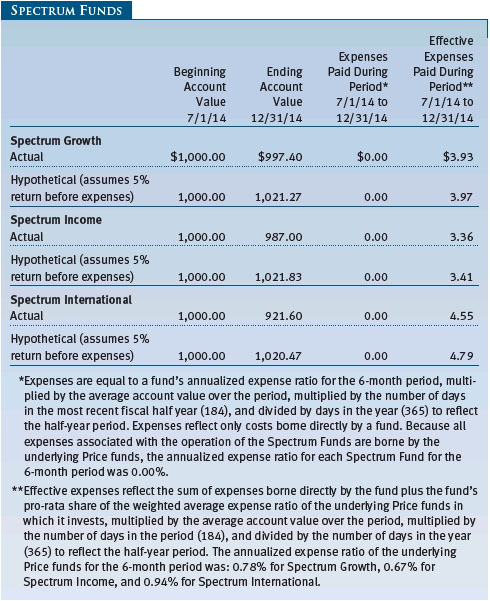
| T. Rowe Price Spectrum Growth Fund |
|
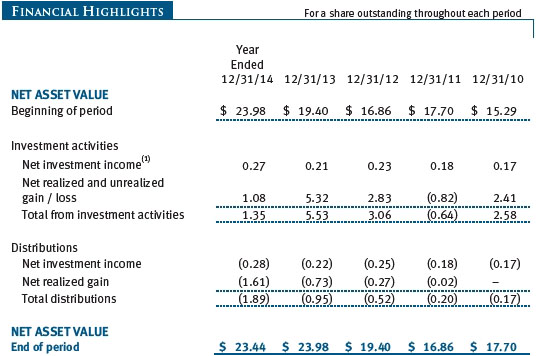
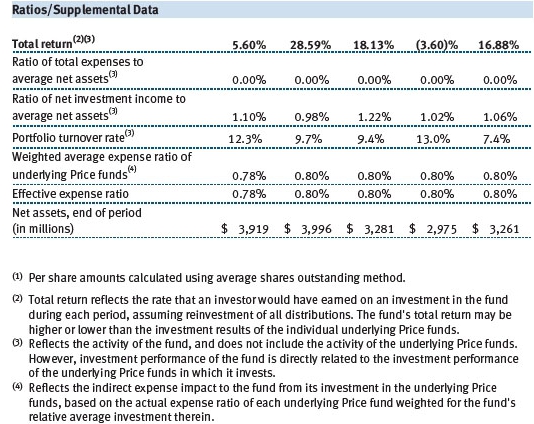
The accompanying notes are an integral part of these financial statements.
| T. Rowe Price Spectrum Income Fund |
|
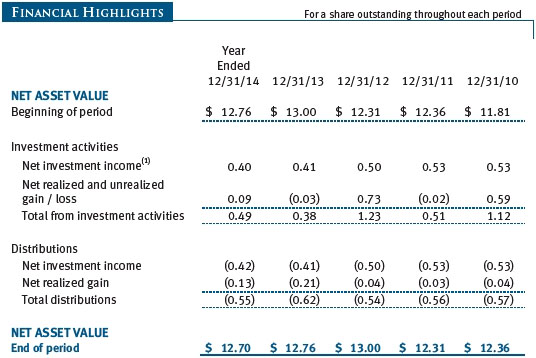
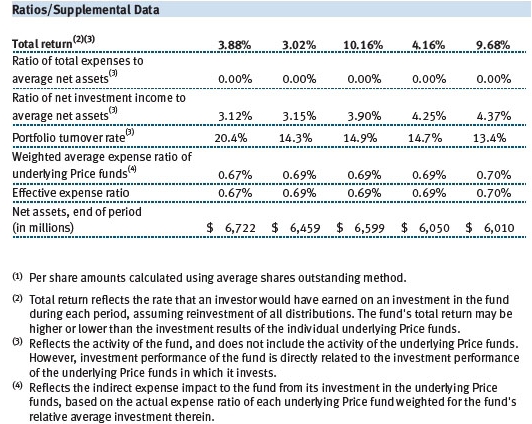
The accompanying notes are an integral part of these financial statements.
| T. Rowe Price Spectrum International Fund |
|
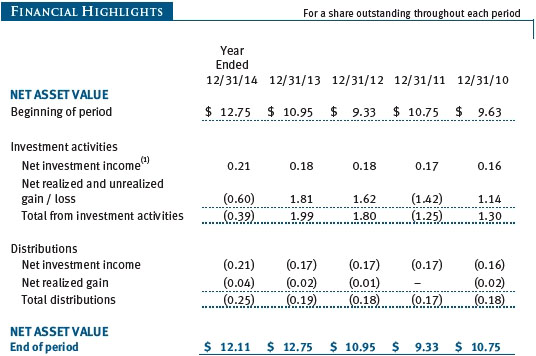
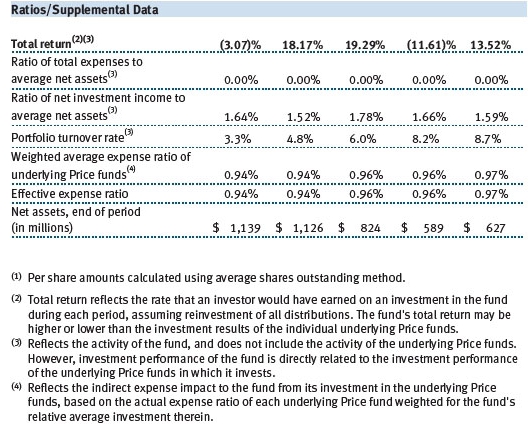
The accompanying notes are an integral part of these financial statements.
| T. Rowe Price Spectrum Growth Fund |
|
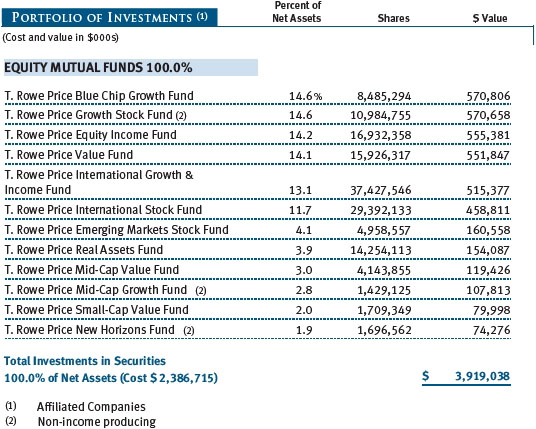
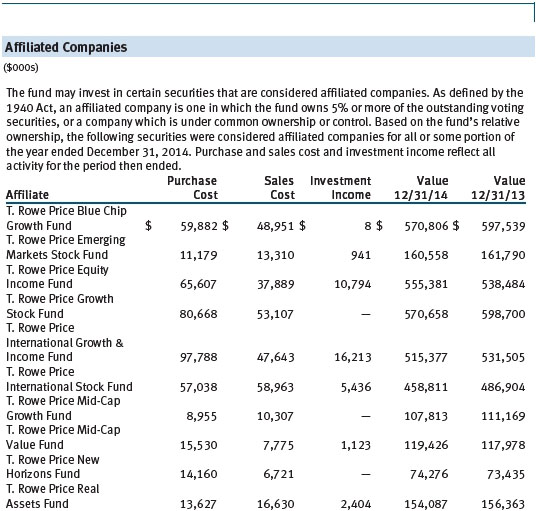
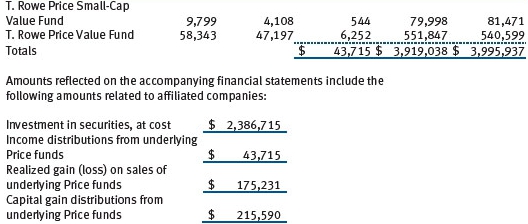
The accompanying notes are an integral part of these financial statements.
| T. Rowe Price Spectrum Income Fund |
|
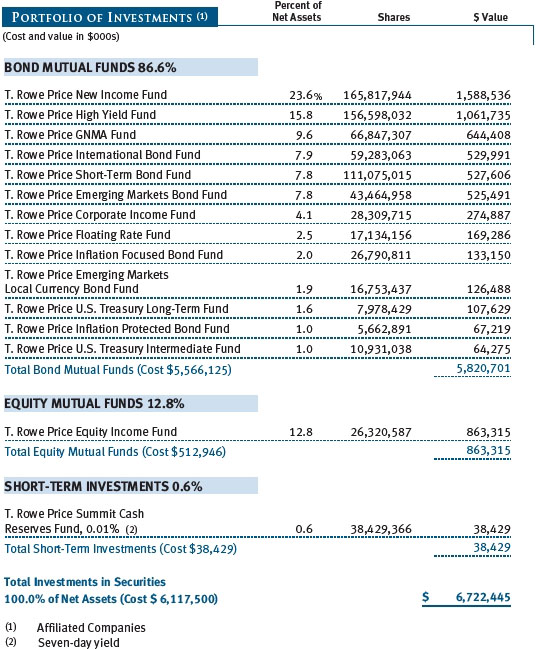
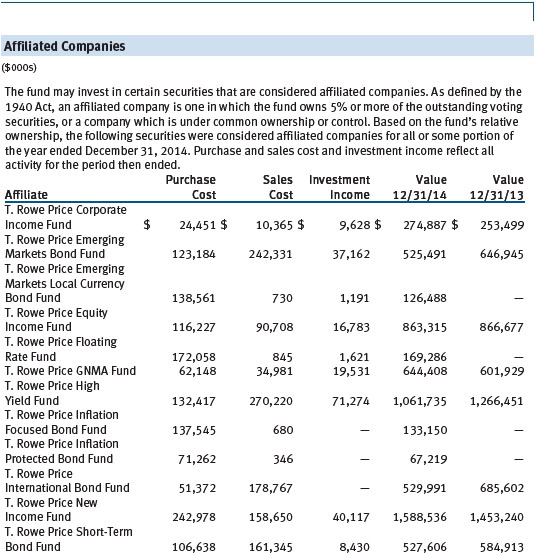
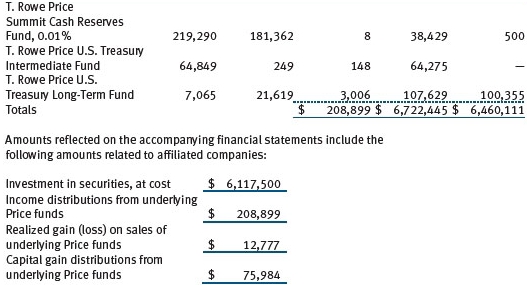
The accompanying notes are an integral part of these financial statements.
| T. Rowe Price Spectrum International Fund |
|
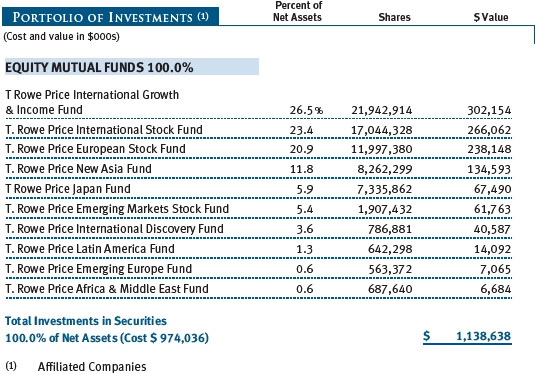
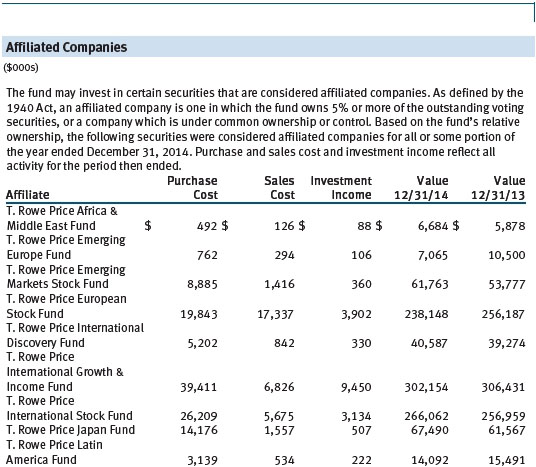
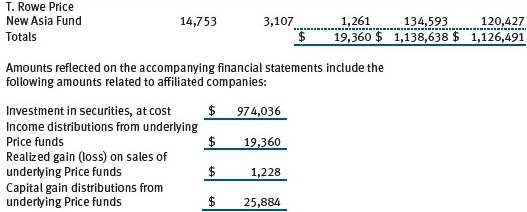
The accompanying notes are an integral part of these financial statements.
| T. Rowe Price Spectrum Growth Fund |
|
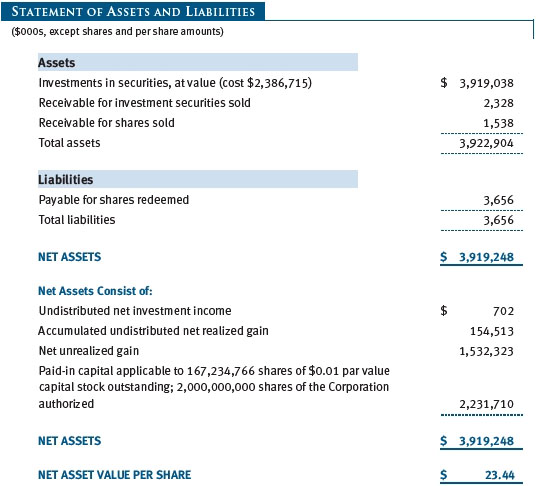
The accompanying notes are an integral part of these financial statements.
| T. Rowe Price Spectrum Income Fund |
|
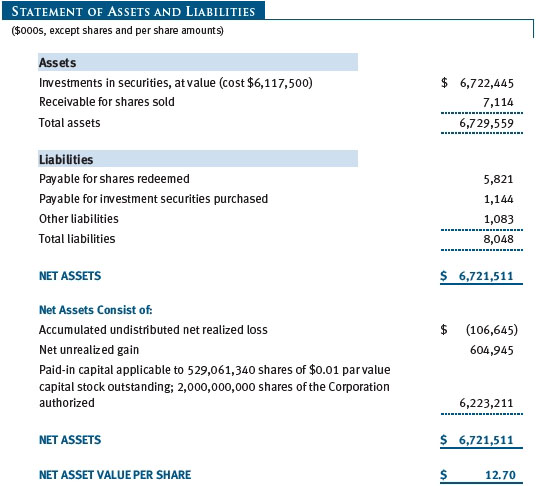
The accompanying notes are an integral part of these financial statements.
| T. Rowe Price Spectrum International Fund |
|
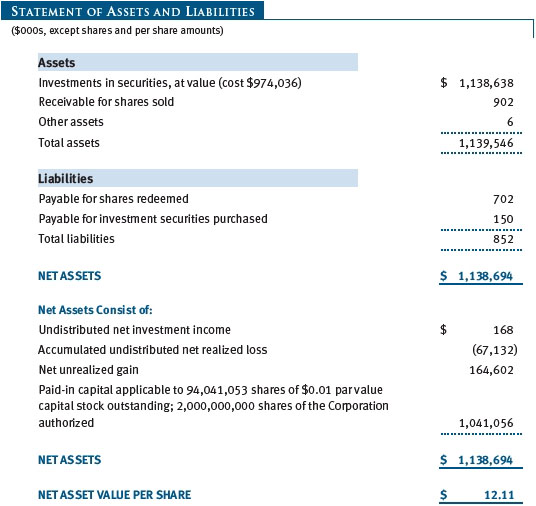
The accompanying notes are an integral part of these financial statements.
| T. Rowe Price Spectrum Growth Fund |
|
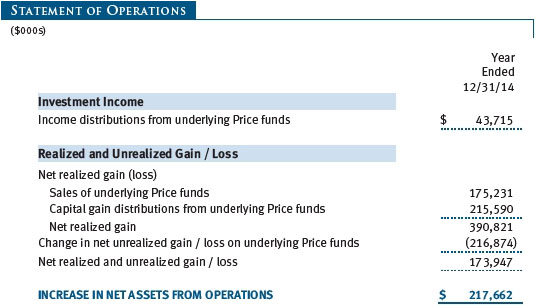
The accompanying notes are an integral part of these financial statements.
| T. Rowe Price Spectrum Income Fund |
|
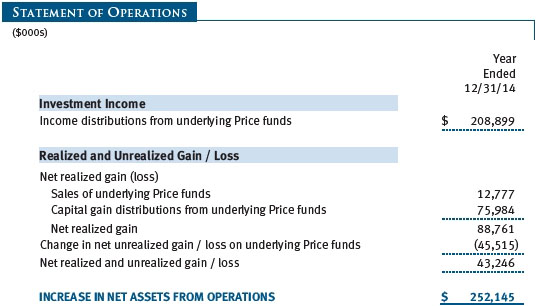
The accompanying notes are an integral part of these financial statements.
| T. Rowe Price Spectrum International Fund |
|
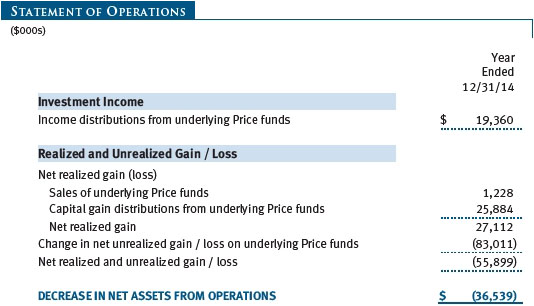
The accompanying notes are an integral part of these financial statements.
| T. Rowe Price Spectrum Growth Fund |
|
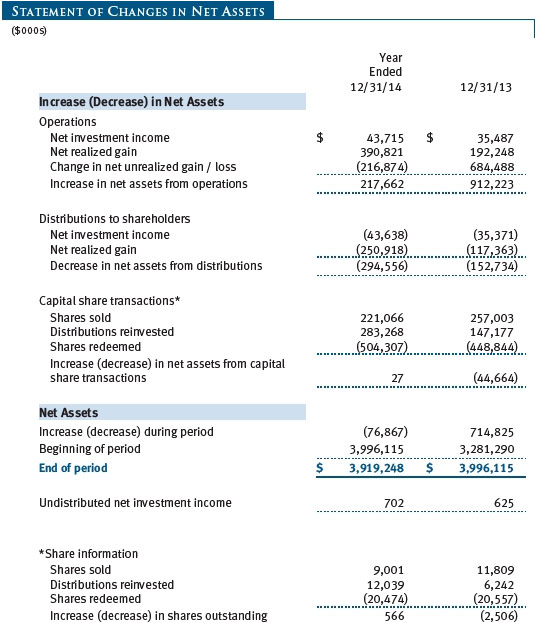
The accompanying notes are an integral part of these financial statements.
| T. Rowe Price Spectrum Income Fund |
|
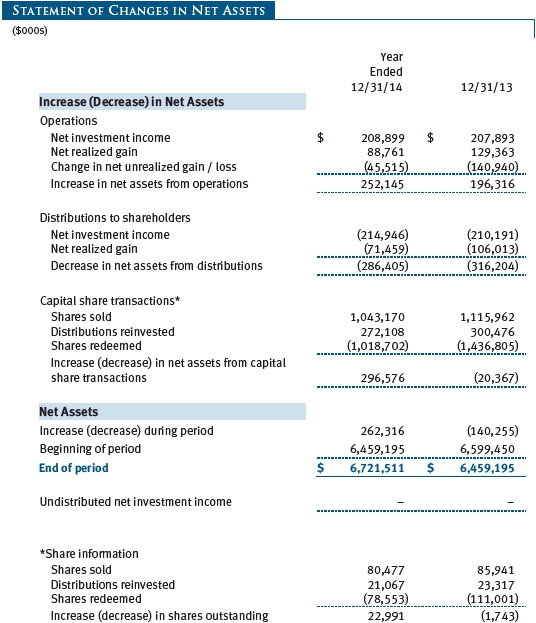
The accompanying notes are an integral part of these financial statements.
| T. Rowe Price Spectrum International Fund |
|
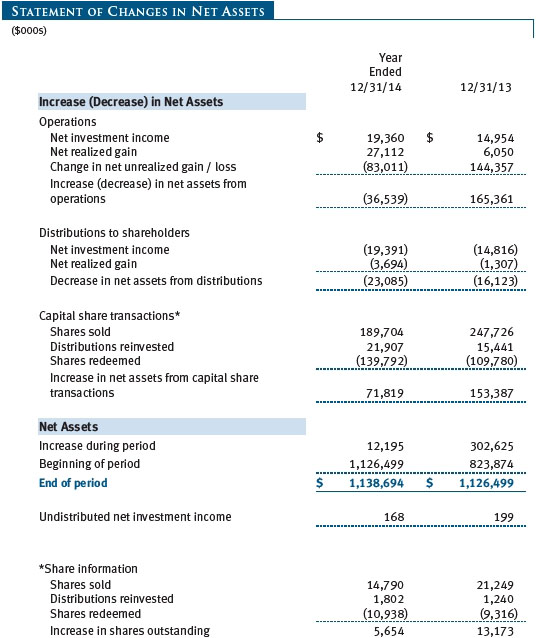
The accompanying notes are an integral part of these financial statements.
| Notes to Financial Statements |
T. Rowe Price Spectrum Fund, Inc. (the corporation), is registered under the Investment Company Act of 1940 (the 1940 Act) as an open-end management investment company. Spectrum Growth Fund, Spectrum Income Fund, and Spectrum International Fund (collectively, the Spectrum Funds) are three portfolios established by the corporation. Spectrum Growth and Spectrum Income commenced operations on June 29, 1990, and Spectrum International commenced operations on December 31, 1996.
Each Spectrum Fund diversifies its assets within specified ranges among a set of T. Rowe Price mutual funds (underlying Price funds) representing specific market segments. Each Spectrum Fund is nondiversified for purposes of the 1940 Act, due to its limited number of investments; however, its investments in underlying Price funds are selected to provide exposure to a diversified portfolio of securities. Spectrum Growth seeks long-term capital appreciation and growth of income with current income as a secondary objective. Spectrum Income seeks a high level of current income with moderate share price fluctuation. Spectrum International seeks long-term capital appreciation.
NOTE 1 - SIGNIFICANT ACCOUNTING POLICIES
Each fund is an investment company and follows accounting and reporting guidance in the Financial Accounting Standards Board Accounting Standards Codification Topic 946 (ASC 946). The accompanying financial statements were prepared in accordance with accounting principles generally accepted in the United States of America (GAAP), including but not limited to ASC 946. GAAP requires the use of estimates made by management. Management believes that estimates and valuations of the underlying Price funds are appropriate; however, actual results may differ from those estimates, and the valuations reflected in the accompanying financial statements may differ from the value ultimately realized upon sale of the underlying Price funds.
Investment Transactions, Investment Income, and Distributions Income is recorded on the accrual basis. Income and capital gain distributions from the underlying Price funds are recorded on the ex-dividend date. Purchases and sales of the underlying Price funds are accounted for on the trade date. Gains and losses realized on sales of the underlying Price funds are reported on the identified cost basis. Income tax-related interest and penalties, if incurred, would be recorded as income tax expense. Distributions to shareholders are recorded on the ex-dividend date. Income distributions are declared by Spectrum Income daily and paid monthly. Income distributions are declared and paid by Spectrum Growth and Spectrum International annually. Capital gain distributions, if any, generally are declared and paid by each fund annually.
Redemption Fees A 2% fee is assessed on redemptions of Spectrum International shares held for 90 days or less to deter short-term trading and to protect the interests of long-term shareholders. Redemption fees are withheld from proceeds that shareholders receive from the sale or exchange of fund shares and are paid to the fund. Redemption fees received by Spectrum International are allocated to each underlying Price fund in proportion to the average daily value of its shares owned by the fund. Accordingly, redemption fees have no effect on the net assets of Spectrum International. The fees may cause the redemption price per share to differ from the net asset value per share.
NOTE 2 - VALUATION
Each fund’s financial instruments are valued, and its net asset value (NAV) per share is computed at the close of the New York Stock Exchange (NYSE), normally 4 p.m. ET, each day the NYSE is open for business. Each fund’s financial instruments are reported at fair value, which GAAP defines as the price that would be received to sell an asset or paid to transfer a liability in an orderly transaction between market participants at the measurement date. Investments in the underlying Price funds are valued at their closing NAV per share on the day of valuation. Assets and liabilities other than financial instruments, including short-term receivables and payables, are carried at cost, or estimated realizable value, if less, which approximates fair value.
The T. Rowe Price Valuation Committee (the Valuation Committee) has been established by the funds’ Board of Directors (the Board) to ensure that financial instruments are appropriately priced at fair value in accordance with GAAP and the 1940 Act. Subject to oversight by the Board, the Valuation Committee develops and oversees pricing-related policies and procedures and approves all fair value determinations. Specifically, the Valuation Committee establishes procedures to value securities; determines pricing techniques, sources, and persons eligible to effect fair value pricing actions; oversees the selection, services, and performance of pricing vendors; oversees valuation-related business continuity practices; and provides guidance on internal controls and valuation-related matters. The Valuation Committee reports to the Board; is chaired by the funds’ treasurer; and has representation from legal, portfolio management and trading, operations, and risk management.
Various valuation techniques and inputs are used to determine the fair value of financial instruments. GAAP establishes the following fair value hierarchy that categorizes the inputs used to measure fair value:
Level 1 – quoted prices (unadjusted) in active markets for identical financial instruments that the fund can access at the reporting date
Level 2 – inputs other than Level 1 quoted prices that are observable, either directly or indirectly (including, but not limited to, quoted prices for similar financial instruments in active markets, quoted prices for identical or similar financial instruments in inactive markets, interest rates and yield curves, implied volatilities, and credit spreads)
Level 3 – unobservable inputs
Observable inputs are developed using market data, such as publicly available information about actual events or transactions, and reflect the assumptions that market participants would use to price the financial instrument. Unobservable inputs are those for which market data are not available and are developed using the best information available about the assumptions that market participants would use to price the financial instrument. GAAP requires valuation techniques to maximize the use of relevant observable inputs and minimize the use of unobservable inputs. When multiple inputs are used to derive fair value, the financial instrument is assigned to the level within the fair value hierarchy based on the lowest-level input that is significant to the fair value of the financial instrument. Input levels are not necessarily an indication of the risk or liquidity associated with financial instruments at that level but rather the degree of judgment used in determining those values. On December 31, 2014, all of the investments in underlying Price funds were classified as Level 1, based on the inputs used to determine their fair values.
NOTE 3 - INVESTMENTS IN UNDERLYING PRICE FUNDS
Purchases and sales of the underlying Price funds during the year ended December 31, 2014, were as follows:

NOTE 4 - FEDERAL INCOME TAXES
No provision for federal income taxes is required since each fund intends to continue to qualify as a regulated investment company under Subchapter M of the Internal Revenue Code and distribute to shareholders all of its taxable income and gains. Distributions determined in accordance with federal income tax regulations may differ in amount or character from net investment income and realized gains for financial reporting purposes. Financial reporting records are adjusted for permanent book/tax differences to reflect tax character but are not adjusted for temporary differences.
Each fund files U.S. federal, state, and local tax returns as required. Each fund’s tax returns are subject to examination by the relevant tax authorities until expiration of the applicable statute of limitations, which is generally three years after the filing of the tax return but which can be extended to six years in certain circumstances. Tax returns for open years have incorporated no uncertain tax positions that require a provision for income taxes.
For the Spectrum Income Fund, reclassifications between income and gain relate primarily to the character of distributions from the underlying Price funds. For the year ended December 31, 2014, the following reclassifications were recorded to reflect tax character; the reclassifications had no impact on results of operations or net assets:

Distributions during the year ended December 31, 2014, were characterized for tax purposes as follows:

Distributions during the prior year ended December 31, 2013, were characterized for tax purposes as follows:

At December 31, 2014, the tax-basis costs of investments and components of net assets were as follows:
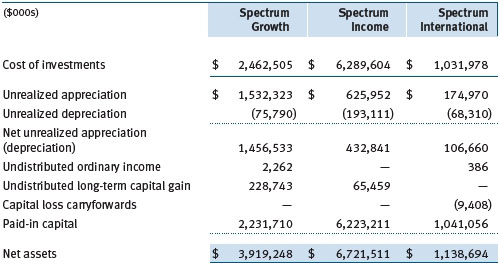
The difference between book-basis and tax-basis net unrealized appreciation (depreciation) is attributable to the deferral of losses from wash sales for tax purposes. Each fund intends to retain realized gains to the extent of available capital loss carryforwards. Because capital loss carryforwards that do not expire are required to be used before capital loss carryforwards with expiration dates, it is possible that all or a portion of the Spectrum International Fund’s capital loss carryforwards subject to expiration could ultimately go unused. During the year ended December 31, 2014, Spectrum International Fund utilized $24,360,000 of capital loss carryforwards. As of December 31, 2014, the Spectrum Growth Fund had no available capital loss carryforwards. The Spectrum Income Fund had no available capital loss carryforwards as of December 31, 2014. Additionally, as of December 31, 2014, the Spectrum International Fund had $9,408,000 of available capital loss carryforwards, which expire as follows: $2,216,000 in 2017 and $7,192,000 in 2018.
NOTE 5 - RELATED PARTY TRANSACTIONS
The Spectrum Funds are managed by T. Rowe Price Associates, Inc. (Price Associates), a wholly owned subsidiary of T. Rowe Price Group, Inc. (Price Group). Price Associates, directly or through sub-advisory agreements with its wholly owned subsidiaries, also provides investment management services to all the underlying Price funds. Pursuant to various service agreements, Price Associates and its wholly owned subsidiaries provide shareholder servicing and administrative, transfer and dividend disbursing, accounting, marketing, and certain other services to the Spectrum Funds. Certain officers and directors of the Spectrum Funds are also officers and directors of Price Associates and its subsidiaries and of the underlying Price funds.
The Spectrum Funds pay no management fees; however, Price Associates receives management fees from the underlying Price funds. The Spectrum Funds operate in accordance with the investment management and special servicing agreements between and among the corporation, the underlying Price funds and Price Associates. Pursuant to these agreements, expenses associated with the operation of the Spectrum Funds are borne by each underlying Price fund to the extent of estimated savings to it and in proportion to the average daily value of its shares owned by the Spectrum Funds. Therefore, each Spectrum Fund operates at a zero expense ratio. However, each Spectrum Fund indirectly bears its proportionate share of the management fees and operating costs of the underlying Price funds in which it invests.
The Spectrum Funds do not invest in the underlying Price funds for the purpose of exercising management or control; however, investments by the Spectrum Funds may represent a significant portion of an underlying Price fund’s net assets. At December 31, 2014, Spectrum Growth Fund held less than 25% of the outstanding shares of any underlying Price fund; Spectrum Income Fund held approximately 44% of the outstanding shares of the Corporate Income Fund, 80% of the Emerging Markets Local Currency Bond Fund, 34% of the Floating Rate Fund, 39% of the GNMA Fund, 29% of the U.S. Treasury Long-Term Fund, and less than 25% of any other underlying Price fund; and Spectrum International Fund held approximately 25% of the outstanding shares of the Japan Fund, and less than 25% of any other underlying Price fund.
Additionally, Spectrum Income Fund is one of several mutual funds in which certain college savings plans managed by Price Associates may invest. Shareholder servicing costs associated with each college savings plan are allocated to Spectrum Income Fund in proportion to the average daily value of its shares owned by the college savings plan and, in turn, are borne by the underlying Price funds in accordance with the terms of the investment management and special servicing agreements. At December 31, 2014, approximately 27% of the outstanding shares of Spectrum Income Fund were held by the college savings plans.
As of December 31, 2014, T. Rowe Price Group, Inc., or its wholly owned subsidiaries owned 2,061,790 shares of Spectrum Growth Fund, representing 1% of the fund’s net assets.
| Report of Independent Registered Public Accounting Firm |
To the Board of Directors of T. Rowe Price Spectrum Fund, Inc. and
Shareholders of T. Rowe Price Spectrum Growth Fund, T. Rowe Price
Spectrum Income Fund, and T. Rowe Price Spectrum International Fund
In our opinion, the accompanying statements of assets and liabilities, including the portfolios of investments, and the related statements of operations and of changes in net assets and the financial highlights present fairly, in all material respects, the financial position of T. Rowe Price Spectrum Growth Fund, T. Rowe Price Spectrum Income Fund and T. Rowe Price Spectrum International Fund (the funds comprising T. Rowe Price Spectrum Fund, Inc., hereafter referred to as the “Funds”) at December 31, 2014, the results of each of their operations, the changes in each of their net assets and the financial highlights for each of the periods indicated therein, in conformity with accounting principles generally accepted in the United States of America. These financial statements and financial highlights (hereafter referred to as “financial statements”) are the responsibility of the Funds’ management. Our responsibility is to express an opinion on these financial statements based on our audits. We conducted our audits of these financial statements in accordance with the standards of the Public Company Accounting Oversight Board (United States). Those standards require that we plan and perform the audit to obtain reasonable assurance about whether the financial statements are free of material misstatement. An audit includes examining, on a test basis, evidence supporting the amounts and disclosures in the financial statements, assessing the accounting principles used and significant estimates made by management, and evaluating the overall financial statement presentation. We believe that our audits, which included confirmation of the underlying funds at December 31, 2014 by correspondence with the transfer agent, provide a reasonable basis for our opinion.
PricewaterhouseCoopers LLP
Baltimore, Maryland
February 13, 2015
| Tax Information (Unaudited) for the Tax Year Ended 12/31/14 |
We are providing this information as required by the Internal Revenue Code. The amounts shown may differ from those elsewhere in this report because of differences between tax and financial reporting requirements.
The funds’ distributions to shareholders included amounts as follows:

For taxable non-corporate shareholders, income represents qualified dividend income subject to a long-term capital gains tax rate of not greater than 20% as follows:

For corporate shareholders, income qualifies for the dividends-received deduction as follows:

The funds will pass through foreign source income and foreign taxes paid, as follows:

| Information on Proxy Voting Policies, Procedures, and Records |
A description of the policies and procedures used by T. Rowe Price funds and portfolios to determine how to vote proxies relating to portfolio securities is available in each fund’s Statement of Additional Information. You may request this document by calling 1-800-225-5132 or by accessing the SEC’s website, sec.gov.
The description of our proxy voting policies and procedures is also available on our website, troweprice.com. To access it, click on the words “Social Responsibility” at the top of our corporate homepage. Next, click on the words “Conducting Business Responsibly” on the left side of the page that appears. Finally, click on the words “Proxy Voting Policies” on the left side of the page that appears.
Each fund’s most recent annual proxy voting record is available on our website and through the SEC’s website. To access it through our website, follow the above directions to reach the “Conducting Business Responsibly” page. Click on the words “Proxy Voting Records” on the left side of that page, and then click on the “View Proxy Voting Records” link at the bottom of the page that appears.
| How to Obtain Quarterly Portfolio Holdings |
The fund files a complete schedule of portfolio holdings with the Securities and Exchange Commission for the first and third quarters of each fiscal year on Form N-Q. The fund’s Form N-Q is available electronically on the SEC’s website (sec.gov); hard copies may be reviewed and copied at the SEC’s Public Reference Room, 100 F St. N.E., Washington, DC 20549. For more information on the Public Reference Room, call 1-800-SEC-0330.
| About the Funds’ Directors and Officers |
Your funds are overseen by a Board of Directors (Board) that meets regularly to review a wide variety of matters affecting or potentially affecting the funds, including performance, investment programs, compliance matters, advisory fees and expenses, service providers, and business and regulatory affairs. The Board elects the funds’ officers, who are listed in the final table. At least 75% of the Board’s members are independent of T. Rowe Price Associates, Inc. (T. Rowe Price), and its affiliates; “inside” or “interested” directors are employees or officers of T. Rowe Price. The business address of each director and officer is 100 East Pratt Street, Baltimore, Maryland 21202. The Statement of Additional Information includes additional information about the fund directors and is available without charge by calling a T. Rowe Price representative at 1-800-638-5660.
| Independent Directors |
| |
| Name | | |
| (Year of Birth) | | |
| Year Elected* | | |
| [Number of T. Rowe Price | | Principal Occupation(s) and Directorships of Public Companies and |
| Portfolios Overseen] | | Other Investment Companies During the Past Five Years |
| | | |
| William R. Brody, M.D., Ph.D. | | President and Trustee, Salk Institute for Biological Studies (2009 to |
| (1944) | | present); Director, BioMed Realty Trust (2013 to present); Director, |
| 2009 | | Novartis, Inc. (2009 to present); Director, IBM (2007 to present) |
| [165] | | |
| | | |
| Anthony W. Deering | | Chairman, Exeter Capital, LLC, a private investment firm (2004 to |
| (1945) | | present); Director, Brixmor Real Estate Investment Trust (2012 to |
| 2001 | | present); Director and Member of the Advisory Board, Deutsche |
| [165] | | Bank North America (2004 to present); Director, Under Armour |
| | (2008 to present); Director, Vornado Real Estate Investment Trust |
| | (2004 to 2012) |
| | | |
| Donald W. Dick, Jr. | | Principal, EuroCapital Partners, LLC, an acquisition and management |
| (1943) | | advisory firm (1995 to present) |
| 1999 | | |
| [165] | | |
| | | |
| Bruce W. Duncan | | President, Chief Executive Officer, and Director, First Industrial |
| (1951) | | Realty Trust, an owner and operator of industrial properties (2009 |
| 2013 | | to present); Chairman of the Board (2005 to present), Interim Chief |
| [165] | | Executive Officer (2007), and Director, Starwood Hotels & Resorts, a |
| | hotel and leisure company (1999 to present) |
| | | |
| Robert J. Gerrard, Jr. | | Advisory Board Member, Pipeline Crisis/Winning Strategies, a |
| (1952) | | collaborative working to improve opportunities for young African |
| 2012 | | Americans (1997 to present); Chairman of Compensation Committee |
| [165] | | and Director, Syniverse Holdings, Inc., a provider of wireless |
| | voice and data services for telecommunications companies (2008 |
| | to 2011) |
| | | |
| Karen N. Horn | | Limited Partner and Senior Managing Director, Brock Capital Group, |
| (1943) | | an advisory and investment banking firm (2004 to present); Director, |
| 2003 | | Eli Lilly and Company (1987 to present); Director, Simon Property |
| [165] | | Group (2004 to present); Director, Norfolk Southern (2008 |
| | to present) |
| | | |
| Paul F. McBride | | Former Company Officer and Senior Vice President, Human |
| (1956) | | Resources and Corporate Initiatives, Black & Decker Corporation |
| 2013 | | (2004 to 2010) |
| [165] | | |
| | | |
| Cecilia E. Rouse, Ph.D. | | Dean, Woodrow Wilson School (2012 to present); Professor and |
| (1963) | | Researcher, Princeton University (1992 to present); Director, MDRC, a |
| 2012 | | nonprofit education and social policy research organization (2011 to |
| [165] | | present); Member, National Academy of Education (2010 to present); |
| | Research Associate, National Bureau of Economic Research’s Labor |
| | Studies Program (2011 to present); Member, President’s Council of |
| | Economic Advisors (2009 to 2011); Chair of Committee on the Status |
| | of Minority Groups in the Economic Profession, American Economic |
| | Association (2012 to present) |
| | | |
| John G. Schreiber | | Owner/President, Centaur Capital Partners, Inc., a real estate |
| (1946) | | investment company (1991 to present); Cofounder and Partner, |
| 2001 | | Blackstone Real Estate Advisors, L.P. (1992 to present); Director, |
| [165] | | General Growth Properties, Inc. (2010 to 2013); Director, BXMT |
| | (formerly Capital Trust, Inc.), a real estate investment company |
| | (2012 to present); Director and Chairman of the Board, Brixmor |
| | Property Group, Inc. (2013 to present); Director, Hilton Worldwide |
| | (2013 to present) |
| | | |
| Mark R. Tercek | | President and Chief Executive Officer, The Nature Conservancy (2008 |
| (1957) | | to present); Managing Director, The Goldman Sachs Group, Inc. |
| 2009 | | (1984 to 2008) |
| [165] | | |
| |
| *Each independent director serves until retirement, resignation, or election of a successor. |
| | |
| Inside Directors |
| |
| Name | | |
| (Year of Birth) | | |
| Year Elected* | | |
| [Number of T. Rowe Price | | Principal Occupation(s) and Directorships of Public Companies and |
| Portfolios Overseen] | | Other Investment Companies During the Past Five Years |
| | | |
| Edward C. Bernard | | Director and Vice President, T. Rowe Price; Vice Chairman of the |
| (1956) | | Board, Director, and Vice President, T. Rowe Price Group, Inc.; |
| 2006 | | Chairman of the Board, Director, and President, T. Rowe Price |
| [165] | | Investment Services, Inc.; Chairman of the Board and Director, |
| | T. Rowe Price Retirement Plan Services, Inc., and T. Rowe Price |
| | Services, Inc.; Chairman of the Board, Chief Executive Officer, |
| | and Director, T. Rowe Price International; Chairman of the Board, |
| | Chief Executive Officer, Director, and President, T. Rowe Price Trust |
| | Company; Chairman of the Board, all funds |
| | | |
| Brian C. Rogers, CFA, CIC | | Chief Investment Officer, Director, and Vice President, T. Rowe Price; |
| (1955) | | Chairman of the Board, Chief Investment Officer, Director, and Vice |
| 2006 | | President, T. Rowe Price Group, Inc.; Vice President, T. Rowe Price |
| [111] | | Trust Company; Vice President, Spectrum Funds |
| |
| *Each inside director serves until retirement, resignation, or election of a successor. |
| Officers | | |
| |
| Name (Year of Birth) | | |
| Position Held With Spectrum Funds | | Principal Occupation(s) |
| | | |
| Christopher D. Alderson (1962) | | Company’s Representative, Director, and Vice |
| Vice President | | President, Price Hong Kong; Director and Vice |
| | President, T. Rowe Price International and |
| | Price Singapore; Vice President, T. Rowe Price |
| | Group, Inc. |
| | | |
| Brian W.H. Berghuis, CFA (1958) | | Vice President, T. Rowe Price, T. Rowe Price |
| Vice President | | Group, Inc., and T. Rowe Price Trust Company |
| | | |
| Darrell N. Braman (1963) | | Vice President, Price Hong Kong, Price |
| Vice President | | Singapore, T. Rowe Price, T. Rowe Price Group, |
| | Inc., T. Rowe Price International, T. Rowe Price |
| | Investment Services, Inc., and T. Rowe Price |
| | Services, Inc. |
| | | |
| Kimberly E. DeDominicis (1976) | | Vice President, T. Rowe Price, T. Rowe Price |
| Vice President | | Group, Inc., and T. Rowe Price International |
| | | |
| Roger L. Fiery III, CPA (1959) | | Vice President, Price Hong Kong, Price |
| Vice President | | Singapore, T. Rowe Price, T. Rowe Price Group, |
| | Inc., T. Rowe Price International, and T. Rowe |
| | Price Trust Company |
| | | |
| John R. Gilner (1961) | | Chief Compliance Officer and Vice President, |
| Chief Compliance Officer | | T. Rowe Price; Vice President, T. Rowe Price |
| | Group, Inc., and T. Rowe Price Investment |
| | Services, Inc. |
| | | |
| David R. Giroux, CFA (1975) | | Vice President, T. Rowe Price, T. Rowe Price |
| Vice President | | Group, Inc., and T. Rowe Price Trust Company |
| | | |
| Gregory S. Golczewski (1966) | | Vice President, T. Rowe Price and T. Rowe Price |
| Vice President | | Trust Company |
| | | |
| Gregory K. Hinkle, CPA (1958) | | Vice President, T. Rowe Price, T. Rowe Price |
| Treasurer | | Group, Inc., and T. Rowe Price Trust Company |
| | | |
| Ian D. Kelson (1956) | | Director and Vice President, T. Rowe Price |
| Vice President | | International; Vice President, T. Rowe Price and |
| | T. Rowe Price Group, Inc. |
| | | |
| Patricia B. Lippert (1953) | | Assistant Vice President, T. Rowe Price and |
| Secretary | | T. Rowe Price Investment Services, Inc. |
| | | |
| David Oestreicher (1967) | | Director, Vice President, and Secretary, T. Rowe |
| Vice President | | Price Investment Services, Inc., T. Rowe Price |
| | Retirement Plan Services, Inc., T. Rowe |
| | Price Services, Inc., and T. Rowe Price Trust |
| | Company; Chief Legal Officer, Vice President, |
| | and Secretary, T. Rowe Price Group, Inc.; Vice |
| | President and Secretary, T. Rowe Price and |
| | T. Rowe Price International; Vice President, |
| | Price Hong Kong and Price Singapore |
| | | |
| Deborah D. Seidel (1962) | | Vice President, T. Rowe Price, T. Rowe Price |
| Vice President | | Group, Inc., T. Rowe Price Investment Services, |
| | Inc., and T. Rowe Price Services, Inc. |
| | | |
| Daniel O. Shackelford, CFA (1958) | | Vice President, T. Rowe Price, T. Rowe Price |
| Vice President | | Group, Inc., and T. Rowe Price Trust Company |
| | | |
| Charles M. Shriver, CFA (1967) | | Vice President, T. Rowe Price, T. Rowe Price |
| President | | Group, Inc., and T. Rowe Price Trust Company |
| | | |
| Robert W. Smith (1961) | | Vice President, T. Rowe Price, T. Rowe Price |
| Vice President | | Group, Inc., and T. Rowe Price Trust Company |
| | | |
| Guido F. Stubenrauch (1970) | | Vice President, T. Rowe Price |
| Vice President | | |
| | | |
| Toby M. Thompson, CFA, CAIA (1971) | | Vice President, T. Rowe Price and T. Rowe Price |
| Vice President | | Group, Inc.; formerly Director of Investments, |
| | I.A.M. National Pension Fund (to 2012) |
| | | |
| Mark S. Vaselkiv (1958) | | Vice President, T. Rowe Price, T. Rowe Price |
| Vice President | | Group, Inc., and T. Rowe Price Trust Company |
| | | |
| Julie L. Waples (1970) | | Vice President, T. Rowe Price |
| Vice President | | |
| | | |
| Richard T. Whitney, CFA (1958) | | Vice President, T. Rowe Price, T. Rowe Price |
| Vice President | | Group, Inc., T. Rowe Price International, and |
| | T. Rowe Price Trust Company |
| |
| Unless otherwise noted, officers have been employees of T. Rowe Price or T. Rowe Price International for at least 5 years. |
Item 2. Code of Ethics.
The registrant has adopted a code of ethics, as defined in Item 2 of Form N-CSR, applicable to its principal executive officer, principal financial officer, principal accounting officer or controller, or persons performing similar functions. A copy of this code of ethics is filed as an exhibit to this Form N-CSR. No substantive amendments were approved or waivers were granted to this code of ethics during the period covered by this report.
Item 3. Audit Committee Financial Expert.
The registrant’s Board of Directors/Trustees has determined that Mr. Anthony W. Deering qualifies as an audit committee financial expert, as defined in Item 3 of Form N-CSR. Mr. Deering is considered independent for purposes of Item 3 of Form N-CSR.
Item 4. Principal Accountant Fees and Services.
(a) – (d) Aggregate fees billed for the last two fiscal years for professional services rendered to, or on behalf of, the registrant by the registrant’s principal accountant were as follows:

Audit fees include amounts related to the audit of the registrant’s annual financial statements and services normally provided by the accountant in connection with statutory and regulatory filings. Audit-related fees include amounts reasonably related to the performance of the audit of the registrant’s financial statements and specifically include the issuance of a report on internal controls and, if applicable, agreed-upon procedures related to fund acquisitions. Tax fees include amounts related to services for tax compliance, tax planning, and tax advice. The nature of these services specifically includes the review of distribution calculations and the preparation of Federal, state, and excise tax returns. All other fees include the registrant’s pro-rata share of amounts for agreed-upon procedures in conjunction with service contract approvals by the registrant’s Board of Directors/Trustees.
(e)(1) The registrant’s audit committee has adopted a policy whereby audit and non-audit services performed by the registrant’s principal accountant for the registrant, its investment adviser, and any entity controlling, controlled by, or under common control with the investment adviser that provides ongoing services to the registrant require pre-approval in advance at regularly scheduled audit committee meetings. If such a service is required between regularly scheduled audit committee meetings, pre-approval may be authorized by one audit committee member with ratification at the next scheduled audit committee meeting. Waiver of pre-approval for audit or non-audit services requiring fees of a de minimis amount is not permitted.
(2) No services included in (b) – (d) above were approved pursuant to paragraph (c)(7)(i)(C) of Rule 2-01 of Regulation S-X.
(f) Less than 50 percent of the hours expended on the principal accountant’s engagement to audit the registrant’s financial statements for the most recent fiscal year were attributed to work performed by persons other than the principal accountant’s full-time, permanent employees.
(g) The aggregate fees billed for the most recent fiscal year and the preceding fiscal year by the registrant’s principal accountant for non-audit services rendered to the registrant, its investment adviser, and any entity controlling, controlled by, or under common control with the investment adviser that provides ongoing services to the registrant were $2,283,000 and $1,691,000, respectively.
(h) All non-audit services rendered in (g) above were pre-approved by the registrant’s audit committee. Accordingly, these services were considered by the registrant’s audit committee in maintaining the principal accountant’s independence.
Item 5. Audit Committee of Listed Registrants.
Not applicable.
Item 6. Investments.
(a) Not applicable. The complete schedule of investments is included in Item 1 of this Form N-CSR.
(b) Not applicable.
Item 7. Disclosure of Proxy Voting Policies and Procedures for Closed-End Management Investment Companies.
Not applicable.
Item 8. Portfolio Managers of Closed-End Management Investment Companies.
Not applicable.
Item 9. Purchases of Equity Securities by Closed-End Management Investment Company and Affiliated Purchasers.
Not applicable.
Item 10. Submission of Matters to a Vote of Security Holders.
Not applicable.
Item 11. Controls and Procedures.
(a) The registrant’s principal executive officer and principal financial officer have evaluated the registrant’s disclosure controls and procedures within 90 days of this filing and have concluded that the registrant’s disclosure controls and procedures were effective, as of that date, in ensuring that information required to be disclosed by the registrant in this Form N-CSR was recorded, processed, summarized, and reported timely.
(b) The registrant’s principal executive officer and principal financial officer are aware of no change in the registrant’s internal control over financial reporting that occurred during the registrant’s second fiscal quarter covered by this report that has materially affected, or is reasonably likely to materially affect, the registrant’s internal control over financial reporting.
Item 12. Exhibits.
(a)(1) The registrant’s code of ethics pursuant to Item 2 of Form N-CSR is attached.
(2) Separate certifications by the registrant's principal executive officer and principal financial officer, pursuant to Section 302 of the Sarbanes-Oxley Act of 2002 and required by Rule 30a-2(a) under the Investment Company Act of 1940, are attached.
(3) Written solicitation to repurchase securities issued by closed-end companies: not applicable.
(b) A certification by the registrant's principal executive officer and principal financial officer, pursuant to Section 906 of the Sarbanes-Oxley Act of 2002 and required by Rule 30a-2(b) under the Investment Company Act of 1940, is attached.
SIGNATURES
Pursuant to the requirements of the Securities Exchange Act of 1934 and the Investment Company Act of 1940, the registrant has duly caused this report to be signed on its behalf by the undersigned, thereunto duly authorized.
T. Rowe Price Spectrum Fund, Inc.
| | By | /s/ Edward C. Bernard |
| | Edward C. Bernard |
| | Principal Executive Officer |
| |
| Date February 13, 2015 | | |
Pursuant to the requirements of the Securities Exchange Act of 1934 and the Investment Company Act of 1940, this report has been signed below by the following persons on behalf of the registrant and in the capacities and on the dates indicated.
| | By | /s/ Edward C. Bernard |
| | Edward C. Bernard |
| | Principal Executive Officer |
| |
| Date February 13, 2015 | | |
| |
| |
| By | /s/ Gregory K. Hinkle |
| | Gregory K. Hinkle |
| | Principal Financial Officer |
| |
| Date February 13, 2015 | | |


























































